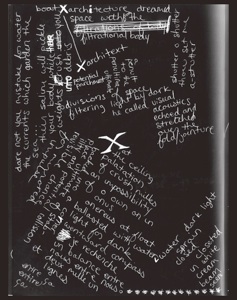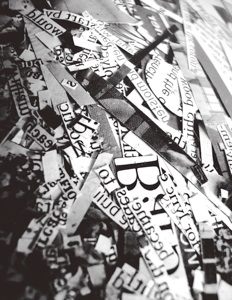Clarity Speaks of a Crystal Sea by Afton Wilky
110 pages, 7x9, w/ foldout poster, $18
Clarity Speaks of a Crystal Sea asks what would happen if we allowed visual and auditory connections space to develop, extend and accrue. This extension and accrual is a narrative in and of itself while the trajectory and transformation of linguistic characters becomes character. The project borrows language; cuts and refolds it; bodies; it bodies; it requires more than one mouth; more than one pair of eyes; it becomes language with a visible shadow.
Through formal experimentation this text builds to find out. Rather than finding a “transparent medium” I hope that readers begin to feel this excess of possible meaning viscerally. If clarity exists, it is an illusion produced by instability. If clarity speaks of a crystal sea, it is perhaps for want of one.
Praise
When we’re ready to see (and sea) the deep weave of our world-making as well as its surface, when our clarity includes the fact of the medium itself, when we speak of our own speaking and acknowledge that material as some large part of what matters to us—then we will be ready to comprehend reality in all its complexity. Afton Wilky’s work is to poetry what string theory is for physics; a necessary next step, a way into a world of mutability and possibility, an invitation to participate in meaning-making in the “textureecho,” strand by strand, opening after opening, in the churn of a restless semantic evolution, “at the place where sounds intersect.” Paronomasia and neologisms find a new fluency where English itself, as Wilky writes, “a pleasure put out to sea,” as, awash with a powerful music, this work compels exploration and experiment. It’s never been so exquisite to make our way(s) through “the mirror image of letters” as it is in this extraordinary, original, ground-breaking book.
— Laura Mullen
In Afton Wilky’s Clarity Speaks of a Crystal Sea, entire rooms of installation are captivated by book form. The pages hold out paper sculptures, words in compound trains and scatters, and juxtapositions of wrought and abandoned explanation, while the character Haada acts in story fragments that bring us closer in to this book’s “blinkers and the stammering whispers.” An incredible balance between openness – text in movement – and refinement – text brought to a pitch of expressive preparation – is part of what makes you feel you are in the room where it’s happening. Hand-writing entries, cutting-room floor word piles, the thirsty water glasses, the photographed concertinas and text-braids: all these elements are paced to make the book a whole experience, air shifting through the brain and black ink at the heart. This is “piling” at its excruciatingly breathing hinge, and it’s beautiful.
— Lisa Samuels
Here the pleasures of the text are returned to the materiality of making, finding, and recasting the said and the scrawled back into the ghostly machine of saying. Afton Wilky’s texts outdo their surfaces and conjure a physicality; and this book binds its curiosities and detours to the puzzling work of what the world of letters and white space and the technology of the book itself might learn to become. I’m thinking of Gordon Matta-Clark’s sketches and photographs of the buildings he’d dismantled: part blueprint, part attempt, part scribbled investigation, and part relic of the gone. Whether frayed, scissored, collaged, printed, erased, or scrawled, Wilky’s condensary of texts is the result of exploring the materials themselves—catalyzing each crazed, folded, obfuscated, or exclamatory word. What’s alive in the margin, breathing in the betweens, is a moving set of texts arrested by its particulars, by its having-been-made, and held however temporarily for us to wonder ourselves into as poesis-in-action—frozen, but seething.
— Joshua Marie Wilkinson




